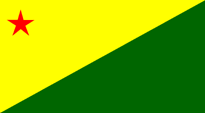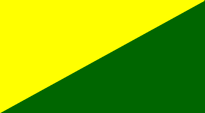Acre |
|
|
|
| Übersicht – Contents: | |
Diese Seite ist Teil des Projektes
Acre |
|
|
|
| Übersicht – Contents: | |
Flagge – Flag: |
|
 |
seit/since 1903, Flagge des Bundesstaats – flag of the federal state, Seitenverhältnis – ratio: 11:20 auch/also 7:10, Quelle/Source nach/by: Flags of the World |
historische Flagge – historical Flag: |
|
 |
1899–1900, Nationalflagge – national flag, Quelle/Source nach/by: Flags of the World |
Bedeutung/Ursprung der Flagge – Meaning/Origin of the Flag: |
|
| Die Flagge von Acre wurde am 14.07.1899 im Zusammenhang mit der Ausrufung der Republik Acre ("1. Republik") angenommen. Sie ist diagonal zwischen Gelb und Grün geteilt, und zeigt seit der Proklamation der "3. Republik" am 27.01.1903 einen fünfzackigen roten Stern im Obereck. Die Hinzufügung des Sterns geht auf Placido de Castro zurück, den Anführer des Aufstandes von 1902, der in der Ausrufung der "3. Republik" gipfelte. Der Stern sollte eine erwünschte Annäherung an Brasilien verdeutlichen. Zur Bedeutung und dem Ursprung der Farben der Flagge gibt es zwei Theorien: | The flag of Acre was adoped on the 14th of July in 1899 in context with the proclamation of the Republic of Acre ("1st Republic"). It is diagonally divided between yellow and green and shows since the proclamation of the "3rd Republic" on the 27th of Janaury in 1903 a five-pointed red star in the upper staff quadrant. The addition of the star was made by Placido de Castro – the leader of the rebellion of 1902 – which culminated in the proclamation of the "3rd Republic". The star should express a desired convergence to Brazil. To the meaning and the origin of the colours of the flag there are two theories: |
|
• Gelb und Grün sind die
Nationalfarben Brasiliens und sollten seit der Ausrufung der Republik Acre
und der Einführung ihrer Flagge eine erwünschte Annäherung an Brasilien
ausdrücken. • Gelb steht für die Bodenschätze des Landes und Grün für seinen Waldreichtum, während das Rot des Sterns für die Bevölkerung steht und Mut symbolisiert. Die Flagge von 1903 wurde 01.03.1963 erneut als Flagge für den Bundesstaat Acre bestätigt. |
• Yellow and green are
the national colours of Brazil and should express since the proclamation of
the Republic of Acre and the introduction of its flag a desired convergence
to Brazil. • Yellow stands for the mineral resources of the country and green for its forestal abundance while the red of the star stands for the people and symbolizes courage. The flag of 1903 was confirmed again on 1st of March in 1963 as flag for the fed. state of Acre. |
|
|
|
|
Es existieren
Reproduktionen der Flagge von Acre, welche die diagonale Teilung von links
oben nach rechts unten verlaufend zeigen. Das diese Flagge einmal so
ausgesehen hat, ist sehr unwahrscheinlich, denn es gibt keinerlei Dokumente
(Verfassung, Gesetze etc.), die den Beschluss des Staate Acre dokumentieren,
die Teilung später umzukehren. Die Teilung von links oben nach rechts unten
geht wahrscheinlich auf Beobachtungen und Beschreibungen von Zeitzeugen
zurück, welche die Flagge damals im Einsatz gesehen haben. Dazu ist zu bemerken, dass historisch überlieferte Beschreibungen von Flaggen häufig nur beiläufig und oberflächlich gemacht wurden, und oft gar nicht die Absicht oder auch die Fähigkeit vorhanden war, eine heraldische Studie abzufassen. Die Flaggengeschichte der gesamten Welt kennt dieses Problem. Man denke nur an die frühen Formen der Flagge der USA, oder der früheren Marineflaggen der USA, an Darstellungen der deutschen schwarz - rot - goldenen Flagge usw. Es kommt dazu, dass Flaggen am Mast nur schwer zu erkennen und zu beschreiben sind, Flaggenbeschreibungen richtig übersetzt und wiedergegeben werden müssen, die Flagge auch richtig herum gehisst sein muss, und von der richtigen Seite betrachtet werden muss. Im konkreten Fall von Acre gibt es eine genaue Beschreibung des Wappens (siehe bei Flags of the World) durch einen Zeitzeugen. Ein Sachverhalt der mehr Sorgfalt verlangt und viele Fehlerquellen ausschließt. Das Wappen zeigte gemäß dieser Beschreibung Flaggen, welche die Diagonale von rechts unten nach links oben verlaufen lassen, so dass mit einiger Sicherheit anzunehmen ist, dass dies die richtige Darstellung der Diagonale ist. |
There circulate
reproductions of the flag of Acre which show the diagonal partition passing
from left above to right below. That this flag once had this design is very
improbable because there are no documents (constitution, laws etc.) which
document the decision of the State of Acre to inverse the partition later.
The partition from left above to right below has its roots possibly in observations and descriptions of contemporary witnesses which saw the flag in use. About it is to comment that historical down handed descriptions of flags were done often just incidentally and desultory, and often there was no intention or as well the ability to draft a heraldical study. The history of flags in the whole world knows this problem. There is to remember the early form of the flag of the USA or the early naval flag of the USA, or the reproductions of the German black - red - golden flag etc. There is to include further that flags on the mast are to recognize hardly and to describe hardly too, descriptions of flags have to be translated(sic!) and given out correctly, and the flag has to be hoisted correctly und seen from the right side. In the concrete case of Acre exists a precise description of the coat of arms (look Flags of the World) by a contemporary witness. A fact which needs more care and excludes many sources of errors. This coat of arms showed in accordance with the description flags which show the diagonal from right below to left above, so that it is to assume with some certainty that this is the correct reproduction of the diagonal. |
| Quelle/Source: Flags of the World, Volker Preuss | |
| Landkarte – Map: |
|
Zahlen und Fakten – Numbers and Facts: |
|
|
|
|
|
|
|
|
|
|
|
|
|
|
|
|
Geschichte: |
| 14.07.1899
· Gründung der Republik Acre ("1. Republik") durch den Abenteurer Luis Galvez
Rodriguez de Arias mit Unterstützung des brasilianischen Bundesstaates Amazonas in dem
zwischen Brasilien, Bolivien und
Peru umstrittenen Gebiet März 1900 · Einmarsch bolivianischer Truppen, die Regierung von Acre geht in den Untergrund 17.09.1900 · antibolivianischer Aufstand November 1900 · Erneute Ausrufung der Republik Acre ("2. Republik") 25.12.1900 · Niederschlagung des Aufstands und der Republik durch bolivianische Truppen 11.07.1901 · Bolivien beschließt Acre an US-amerikanische und britische Investoren zu verpachten 06.08.1902 · erneuter antibolivianischer Aufstand der Bevölkerung von Acre, auch mit Unterstützung der "Gummibarone", es kommt zum regulieren Krieg gegen Bolivien 24.01.1903 · Ende des Krieges 27.01.1903 · Erneute Ausrufung der Republik Acre ("3. Republik") 17.11.1903 · Vertrag von Petropolis, Acre wird zwischen Brasilien, Bolivien und Peru aufgeteilt, Ende der Republik Acre 25.02.1904 · Acre wird in drei Distrikte aufgeteilt und Brasilien als Bundesterritorium angegliedert 07.04.1904 · Acre wird Bundesterritorium 15.06.1962 · Acre wird Bundesstaat Brasiliens |
History: |
| 14th of July
1899 · foundation of the Republic of Acre ("1st Republic") by the
adventurer Luis Galvez Rodriguez de Arias with support of the Brazilian federal state of
Amazonas within the between Brazil, Bolivia and
Peru vexed area March 1900 · invasion of Bolivian troops, the government of Acre goes underground 17th of September 1900 · Anti-Bolivian riot November 1900 · one more proclamation of the Republic of Acre ("2nd Republic") 25th of December 1900 · suppression of the riot and the republic by Bolivian troops 11th of July 1901 · Bolivia decides to lease Acre to US-American and British investors 6th of August 1902 · one more Anti-Bolivian riot of the people of Acre, even with assistance of the "Rubber Barons", it comes into being a regular war against Bolivia 24th of January 1903 · end of the war 27th of January 1903 · one more proclamation of the Republic of Acre ("3rd Republic") 17th of November 1903 · Treaty of Petropolis, Acre becomes divided between Brazil, Bolivia and Peru, end of the Republic of Acre 25th of Feruary 1904 · acres becomes divided into three districts and is annexed by Brazil as a federal territory 7th of April 1904 · Acre becomes a Federal Territory 15th of June 1962 · Acre becomes a state of Brazil |
| Quelle/Source: nach/by Wikipedia (D), World Statesmen |
Ursprung des Landesnamens – Origin of the Country's Name: |
|
| Das Land ist wahrscheinlich nach dem Fluss "Acre" benannt, der hier seine Quelle hat, und an dem die Hauptstadt Rio Branco liegt. Die Region Acre gehörte früher zum Einflussbereich der Spanischen Sprache. Das Spanische Wort "acre" heißt übersetzt: "beißend", "scharf", "sauer" oder auch "herb". Das könnte sich vielleicht auf den eventuell sehr eigentümlichen Geschmack des Wasseres des Flusses Acre beziehen, oder beschreibt möglicherweise die unwirtlichen klimatischen Bedingungen in dieser Gegend. | The country is probably
named after the River "Acre", which has its source here, and the capital
Rio Branco is placed on its bank. The region of Acre was formerly part of the area of
influence of the Spanish language. The Spanish word "acre" means:
"biting", "sharp", "sour" or "herb". This could
possibly relate to the possibly very peculiar taste of the water of the River Acre, or may
possibly describe the harsh climatic conditions in the area. |
| Quelle/Source: Volker Preuss | |
| Mit
freundlicher Untersützung von: Kindly supported by: |
Wolgang Marx (D) |